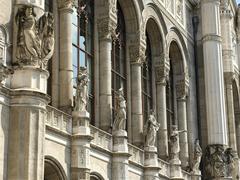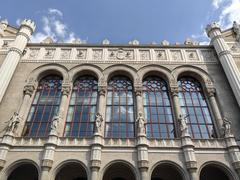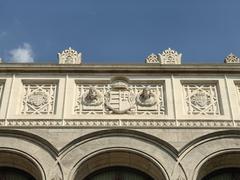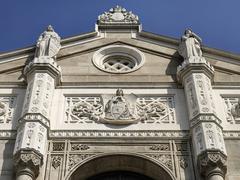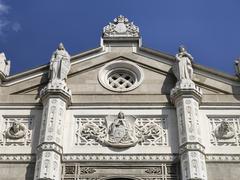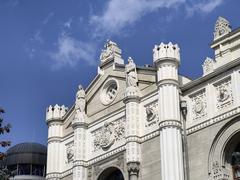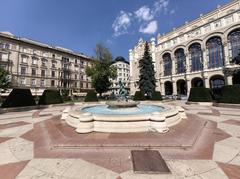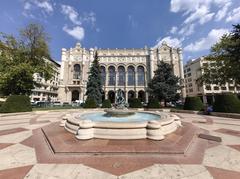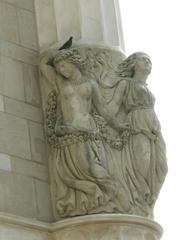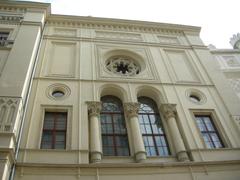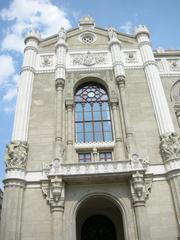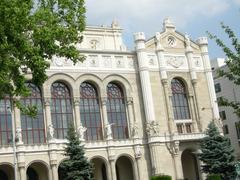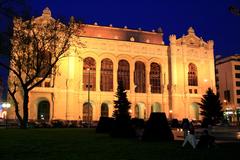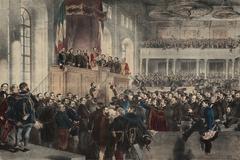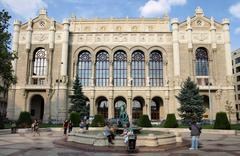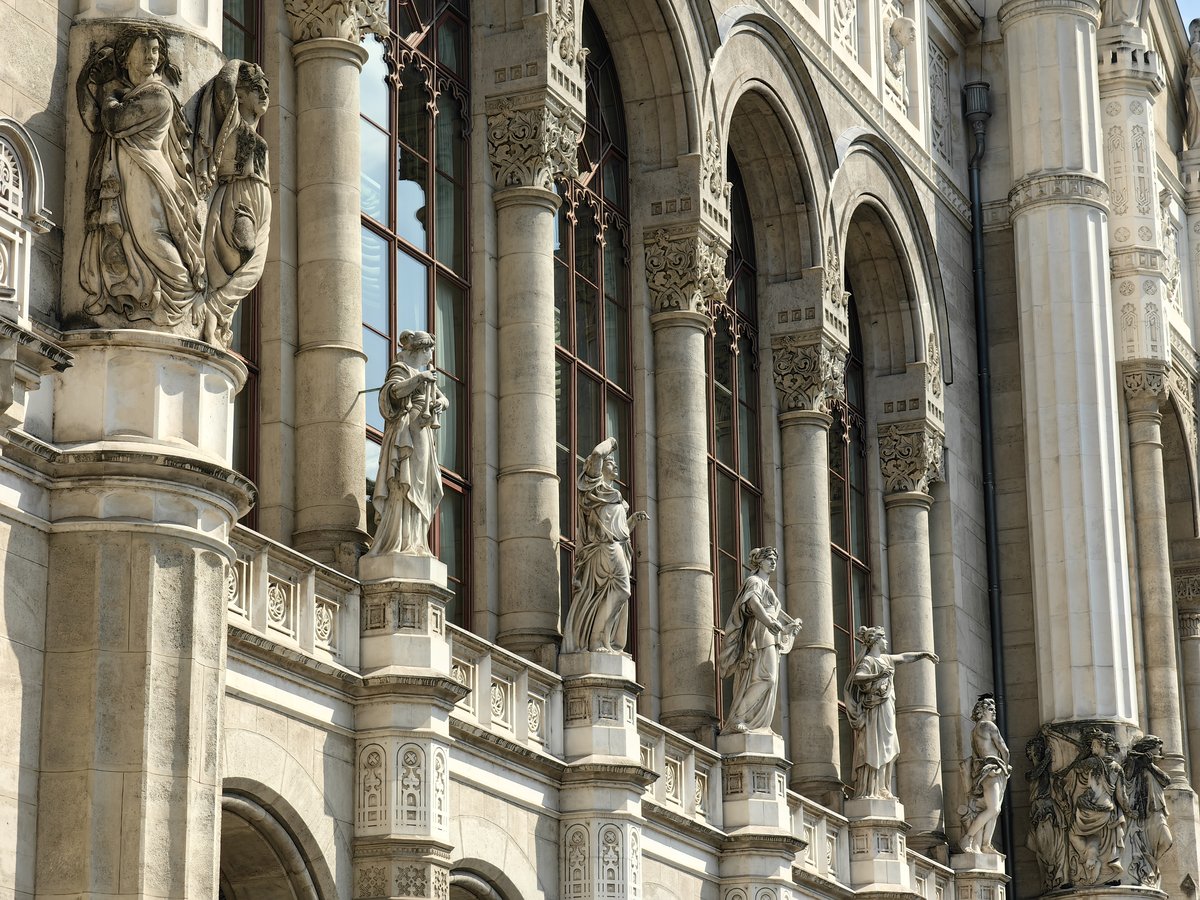
Vigadó Concert Hall Budapest: Visiting Hours, Tickets, and Historical Information
Date of Publication: 14/06/2025
Introduction
Situated on the picturesque banks of the Danube River in the heart of Pest, the Vigadó Concert Hall—known as Pesti Vigadó—stands as one of Budapest’s most iconic cultural and historical landmarks. Since its opening in the 19th century, Vigadó has played a crucial role in Hungary’s artistic life, hosting legendary composers, serving as a stage for national celebrations, and embodying the city’s architectural ingenuity. Today, Vigadó offers visitors not only world-class performances but also guided tours, exhibitions, and panoramic views of Budapest’s skyline (World Concert Hall; CNN Travel; city-sightseeing.info).
This detailed guide covers the Vigadó’s history, architectural highlights, cultural significance, practical visitor information—including visiting hours and ticketing—accessibility features, and nearby attractions. Whether you’re an architecture enthusiast, music lover, or traveler seeking Budapest’s cultural riches, this article provides everything you need for a memorable visit.
Historical Overview
Origins and Early History
The Vigadó stands on the site of the original “Redoute,” a neoclassical event hall designed by Mihály Pollack and completed in 1833. The Redoute quickly became Pest’s cultural epicenter, hosting balls, concerts, and political events. However, it was destroyed during the 1848–49 Hungarian War of Independence.
Rebirth and Architectural Innovation
Following the Redoute’s destruction, Frigyes Feszl was commissioned to design a replacement. Completed in 1865, the new Vigadó showcased a blend of Romantic, Moorish, and Gothic styles, reflecting Hungary’s diverse artistic influences. Feszl’s design featured ornate façades, grand arches, and lavish interiors, establishing the Vigadó as a symbol of national pride and resilience (World Concert Hall).
Cultural Significance
Throughout its history, Vigadó has been central to Hungary’s cultural life. Renowned composers such as Franz Liszt, Béla Bartók, and Johannes Brahms performed here. The hall has also hosted key civic events, including the 1867 coronation ball for Emperor Franz Joseph I and the celebration of Budapest’s unification in 1873 (city-sightseeing.info; hungarytoday.hu).
Wartime Damage and Restoration
Vigadó suffered severe damage during World War II and remained closed for decades. Declared a historic monument in 1954, it underwent multiple restorations and reopened in 1980. A comprehensive renovation completed in 2014 restored the building’s original grandeur, modernized its facilities, and introduced new exhibition spaces and a panoramic terrace (vigado.hu).
Architectural Marvels
Exterior Features
The Vigadó’s façade is a masterpiece of 19th-century Hungarian eclecticism, combining Moorish horseshoe arches, Gothic verticality, and Romantic ornamentation. Statues and reliefs depict allegorical figures and national icons. The building’s light-colored stone glows at night, making it a beacon along the Danube (CNN Travel; Budapest Tours).
Interior Highlights
Upon entering, visitors are welcomed by a grand marble staircase and a richly decorated foyer. The main concert hall features a vaulted ceiling adorned with frescoes and gilded stucco, massive crystal chandeliers, and seating for about 700 guests. Auxiliary salons and galleries host art exhibitions and chamber performances, all unified by exquisite detailing (CNN Travel; Budapest Tours).
Integration with the Cityscape
Vigadó’s strategic location on the Danube Promenade offers stunning views of Buda Castle, Chain Bridge, and the city skyline, making it a focal point for both architecture and scenery (Budapest Tours).
Cultural and Social Legacy
Vigadó has played host to some of Hungary’s most significant cultural moments, including the premiere of Brahms’s Piano Concerto in B-flat major in 1881 and performances by the Budapest Philharmonic Orchestra. It has also served as a venue for coronation balls, the city’s unification celebration, and countless artistic milestones (city-sightseeing.info; hungarytoday.hu; visithungary.com).
Today, Vigadó is a dynamic cultural center, regularly hosting concerts, folk dance, contemporary art exhibitions, literary events, and children’s programs. Its commitment to cultural diversity and excellence makes it a vital part of Budapest’s artistic landscape (budapestbylocals.com; budapest.city).
Visiting Vigadó Concert Hall: Essential Information
Location & Access
- Address: Vigadó tér 2, 1051 Budapest, Hungary
- Public Transport: Easy access by tram line 2 and metro lines M1, M2, M3 (Vörösmarty tér station). Walking distance from Chain Bridge, Váci utca, and Vörösmarty Square (budappest.com).
Visiting Hours
- Box Office & Visitor Areas: Typically open daily from 10:00 AM to 6:00 PM; extended on event days; closed Sundays outside event periods. Always check the official website for current hours.
Tickets & Admission
- Concerts: Prices range from 3,000 to 15,000 HUF (€8–€40); discounts for students, seniors, and groups.
- Exhibitions & Tours: Admission usually around 2,500 HUF.
- Purchase: Online via the official Vigadó website, at the box office, or through authorized partners.
- Guided Tours: Available in multiple languages, lasting 45–60 minutes. Advance booking is recommended.
Accessibility
- Wheelchair accessible with ramps and elevators.
- Accessible restrooms and seating.
- Visitors with special needs should notify staff ahead of time for assistance (vigado.hu).
Facilities
- Cloakroom: Complimentary for coats and bags.
- Restrooms: Available on multiple levels.
- Gift Shop: Books, souvenirs, and music.
- Café: Light meals and refreshments with Danube views.
- Dining: On-site Bohém Restaurant, P’Art Coffee House, and nearby restaurants (budapestbylocals.com).
Nearby Attractions
- Chain Bridge & Elisabeth Bridge: Iconic Danube crossings.
- Danube Promenade: Scenic walkway with panoramic views.
- Váci utca: Bustling pedestrian shopping street.
- St. Stephen’s Basilica: Renowned for architecture and organ concerts.
- Hungarian Parliament & Buda Castle: Both within walking distance.
Visitor Experience and Travel Tips
- Language: English widely spoken; event programs often multilingual.
- Payment: Credit cards accepted throughout the venue.
- Security: Bag checks at entrances; large items stored in cloakroom.
- Dress Code: Smart casual for concerts; formal for gala events.
- Photography: Permitted in public areas and during tours; prohibited during performances.
- Children: Family-friendly events offered; some concerts may have age restrictions.
- Best Time to Visit: Late spring and early summer (especially June) for vibrant programming and pleasant weather (budapestbylocals.com).
Visual Highlights
- Exterior view of Vigadó Concert Hall with Danube backdrop (Alt: “Vigadó Concert Hall Budapest exterior overlooking the Danube River”)
- Ornate interior concert hall with audience seating (Alt: “Interior of Vigadó Concert Hall with decorative ceilings and seating”)
- Panoramic terrace view of Budapest skyline (Alt: “Panoramic view of Budapest from Vigadó Concert Hall terrace”)
More images and virtual tours are available on the official Vigadó website.
Frequently Asked Questions (FAQ)
Q: What are the Vigadó Concert Hall visiting hours?
A: Generally, 10:00 AM to 6:00 PM, with extended hours on event days. Always check the official website before your visit.
Q: How do I buy tickets?
A: Tickets can be purchased online, at the box office, or through authorized partners.
Q: Is Vigadó wheelchair accessible?
A: Yes, the venue provides ramps, elevators, and accessible restrooms.
Q: Are guided tours available?
A: Yes, guided architectural and historical tours are offered in multiple languages.
Q: What other attractions are nearby?
A: Chain Bridge, Danube Promenade, Váci utca, Buda Castle, and St. Stephen’s Basilica are all within walking distance.
Summary and Recommendations
The Vigadó Concert Hall is a testament to Budapest’s rich artistic heritage and architectural splendor. From its 19th-century origins through times of destruction and renewal, it has emerged as a beacon of cultural vitality and community spirit. Today, visitors can experience not just magnificent architecture and panoramic views, but also a dynamic program of concerts, exhibitions, and family events (city-sightseeing.info; Budapest by Locals; vigado.hu).
A visit to Vigadó is recommended for anyone seeking an authentic taste of Hungarian culture. Plan ahead by checking visiting hours, booking tickets in advance, and exploring the surrounding attractions for a full Budapest experience.
To stay updated on events and exhibitions, consult the official Vigadó website, and consider downloading the Audiala app for easy ticketing and exclusive content.
Sources
- World Concert Hall
- CNN Travel
- city-sightseeing.info
- vigado.hu
- Budapest by Locals
- Budapest City
- Budapest Tours
- hungarytoday.hu
- visithungary.com
- budappest.com
- wikipedia
